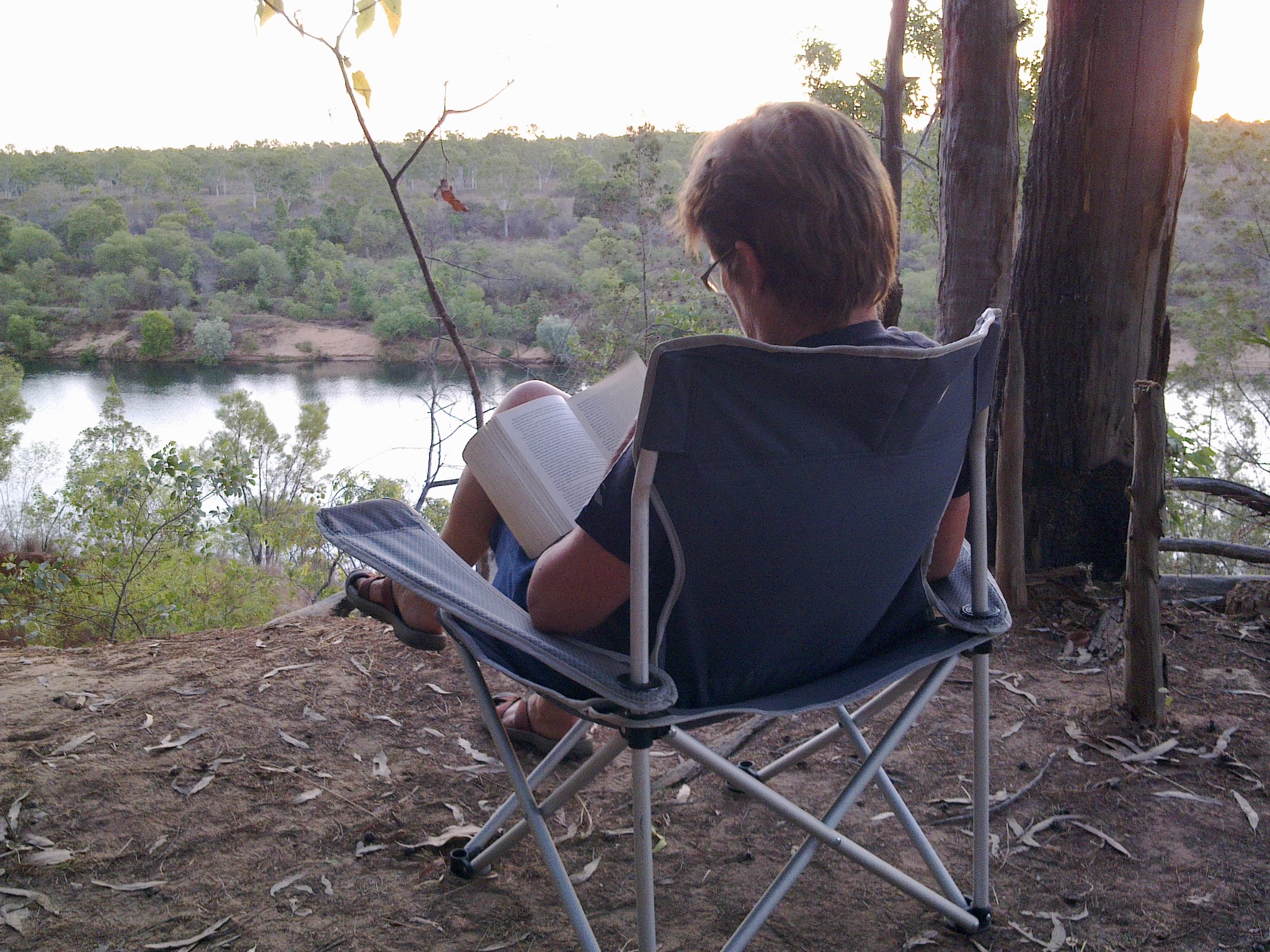Woke before dawn (that seems to be the routine these days) to another magic morning, this time overlooking the Robinson River from our cliff-top vantage point at Seven Emu Station. The station is 880 square miles with the homestead about 5 kilometres south and our nearest camping buddies about 25 kilometres north nearer to the Gulf of Carpentaria and also much close to the water’s edge. Needless to say, we have the place to ourselves.
I started scratching around for a few twigs to get the fire restarted and not long after Glen joined me. Pretty soon the billy had boiled and we were into our first cuppa for the day. While enjoying our cuppa and checking out the numerous fish “rises”, a prehistoric creature of extreme proportions surfaced and drifted by our campsite! Shouts for Wendy to join us seemed to spook the creature and it disappeared from sight as quickly as it appeared. Constant surveillance of the river after lunch has produced a further sighting of a bow wave with nostrils being made by a similarly proportioned creature! We can hardly keep our eyes off the river now in the hope we get further sightings.
After breakfast we headed out north along the track that sweeps by our campsite. We had been told that the track would take us towards the mouth of the river and the Gulf. We pushed off at a fair clip averaging 15 – 20 kph on a single lane track that twisted and turned through the trees and pandanus palms. Our first detour took us down to the river at a point where vehicles could drive on an area of river stones that would be well under water during the wet season (judging by the flood debris sitting high in the trees above us). We cautiously left the Prado for a closer inspection of the river, all the time on the lookout for our prehistoric companion. A few photos later, and a fully rigged handline found under a tree packed away, we were away again driving deeper and deeper into the middle of nowhere.
A few cattle gates later and we came upon a derelict house – roof and frame intact but walls broken up. There were probably a few stories the place had to tell but we read the graffiti on what remained of the walls to try and determine when it fell into disrepair – roughly 1993 based on what we read. It was our guess that a tropical storm or cyclone may have been behind the poor condition the property was in.
We pushed on ever northwards, through a tricky and challenging gully and into an area that signalled we were approaching the Gulf – mangroves started to appear and the river broadened out. We stumbled upon a rough campsite where a boat could be launched and fish cleaning tables were the furniture of preference right on the water’s edge (which didn’t seem particularly croc-wise)!
Our return journey was slightly quicker, with less stops to check out the changing views over the river. The temperature was also hitting 36C and the air conditioning in the Prado was more attractive than the ambient temperature.
It’s been quite a day for spotting wildlife. So far we have seen a huge croc swim by our campsite twice. Sea eagles have circled the river near our campsite. Numerous birds have serenaded us at dawn. Quail scurried away off the track while we were out for a drive. We also managed to unsettle a wedge-tailed eagle who took flight as we approached. Glen and myself watched a snake swim the river near the boat launching campsite and a dingo left a lot of footprints around our camp overnight.
After lunch we have all managed a wash under one of those showers you hang up in a tree. We now all have clean hair but no matter how hard we try, our feet still seem to be dirty! Another camp oven meal is on the menu tonight, along with fire roasted pumpkin and potatoes. It doesn’t get much better than this.
Where is “the middle of nowhere”?
On our adventure we we have often used the phrase “feels like we’re in the middle of nowhere” but increasingly we have begun questioning what qualifies a location as being “nowhere”, let alone in the middle of it.
We began by trying to define it as a place on a map and everything would be relative to that point. For example, you could be:
- close to the middle of nowhere
- just east of the middle of nowhere
- within sight of the middle of nowhere
- 100 kilometres from …..
This definition proved to be too narrow and played down the remoteness of places we have visited. We tried a different approach, listing attributes that either exist or can’t be found “in the middle of nowhere”. Firstly, the attributes that exist “in the middle of nowhere” include:
- no running drinking water (eg. we’re currently taking our drinking water from a drum marked ‘Caution – Caustic’)
- there are less than 3 walls and a door on the toilet
- less than 5 cars pass the campsite in a 24 hour period
- you have to open stock gates to get there
- you have to drive over at least 1 cattle grid to get there
- there is no mobile phone reception in any direction for at least 100 kilometres
- when set to scan, the car radio cannot locate any stations on the AM and FM bands
- you have to cross at least 2 rivers without the aid of bridges to get there
- everything is multi-purpose (eg. the road in is also a runway, the post office sells groceries, etc.)
- the road in is also the road out.
Attributes you won’t find in the middle of nowhere include:
- cheap beer
- cheap fuel.
